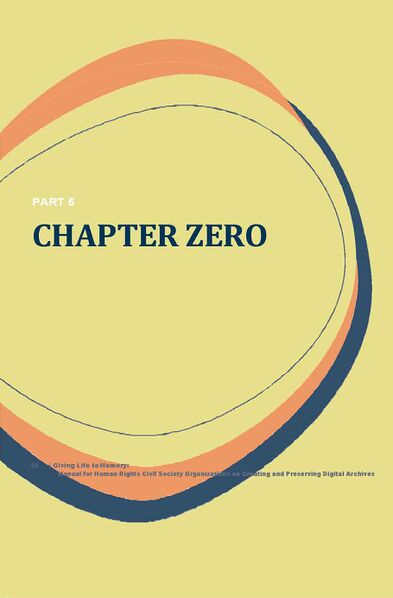Chapter Zero: Difference between revisions
(Prepared the page for translation) |
(Marked this version for translation) |
||
| Line 3: | Line 3: | ||
<translate> | <translate> | ||
== '''What is the archive of a civil society organization?''' == | == '''What is the archive of a civil society organization?''' == <!--T:16--> | ||
Revision as of 17:46, 3 March 2024

What is the archive of a civil society organization?
For civil society organizations, thinking about the archive may seem a technical and distant exercise. However, going back over what has been produced each year allows them to revisit their work processes, recognize their value, and understand that, often unintentionally, they have created their own archive or documentary collection. In addition, undertaking this work is necessary as a basis for facilitating access and consultation and reviewing the conservation status of documents and an opportunity to think about information security, copies and long-term preservation.
The organization of documents, their classification and availability for consultation is also the basis that makes it possible to carry out other initiatives, such as document dissemination exercises in memory actions, the use of sources to continue processes of denunciation and demand for truth, justice, reparation, and in general to have easy access to information for other analytical work, reports, research, among others.
An organization's archive is made up of all the documents received and produced during its work. All organizations have archives, even if they are scattered and disorganized, it is always possible to establish a form of organization that allows their preservation and access.
"A documentary collection or archive collection comprises all the documentation produced, received and gathered by an institution or person in the performance of its functions, regardless of its medium. When we refer to a documentary fonds, we generally talk about the archive of an institution or person. Thus, the name of a fond identifies its producer"
Memoria Abierta, 2023, pg. 13.
The work with civil society archives has expanded the definition of the archive to other formats that are registers of knowledge and cultural expression. Symbolic objects such as sewn dolls, weavings, mandalas, ceramics, T-shirts used in mobilizations, banners, among others, can be incorporated into inventories, for example through photographic records. Their preservation as objects also implies expanding the form of storage and preservation of archives and using tools and knowledge from the world of museums. On the other hand, cultural expressions such as dance, theater, singing, and music, which are ways of recording and transmitting knowledge and memories and are considered a fundamental part of the trajectory and context of an organization, can be recorded in conventional formats (video, audio, transcription, photography) and thus be incorporated into the archive.
Some organizations build databases to record data on cases of human rights violations. For this purpose they collect documentation of different types, formats and media, and in these organizations the documents are the basis for recording the facts. However, on many occasions, the priority is registration, follow-up, and advocacy rather than the archival logic of the documents. In the long term, this puts access and preservation at risk, therefore organizations are encouraged to undertake this type of work.
On the other hand, the digital world has meant an important opportunity for preserving and disseminating document information. To speak of digital archives is to speak of documents in a format and support that implies technological challenges and opportunities for copying, dissemination and analysis of information. Digital documents can be digital natives, created in a digital format (text, image, audio) support (external hard disk, external hard disk, USB, DVD, etc.). Thus, when we talk about digital archives, we are talking about a part of the archive or document collection that is in these formats and supports.
The organization has an archive or document collection that contains both digital and analog documents. Therefore, there is not a digital archive and an analog Archive, and it is the same fund.
Reference to digital archives should not divert our gaze from the complete archive. Each organization has a documentary collection that constitutes a unit. One of the main bases for working with archives is preserving integrity. The archival exercise is a way of understanding the information from its production context.
Therefore, the document is not understood individually but as part of a production logic in archives. Thus, to begin working with an archive, it is necessary to understand the collection as a whole and relate it to the activities and functions of the organization. This way, it is possible to understand the context in which a document is produced or received.
This internal logic of the organization is called a classification table. With this table, which is an exercise of categorizing the documents respecting their origin and original order (to understand with what logic they have been preserved in a specific order). With this table, the general inventory, the detailed description of the content and state of preservation, and, if necessary, digitization can be carried out.
For this reason, archival work cannot begin with a single document but rather with groups of documents that account for the organization's actions, and understanding these actions allows us to understand the context of the document. The context of the document provides information that enriches the meaning and understanding of the document beyond the information it contains.
So, if you come across this manual and you want to digitize or organize your digital documents but have never worked on your organization's archive, please start by doing so. Then, when you want to approach a part of this archive to digitize or organize it, you will be able to place these documents within this general logic.
To follow up on the steps for your archive organization, go to the following:
Addendum I: “Fictional Example of a Human Rights Archive’s Guiding Principles”
Addendum II: “How to Organize Physical Archives in 10 Steps”